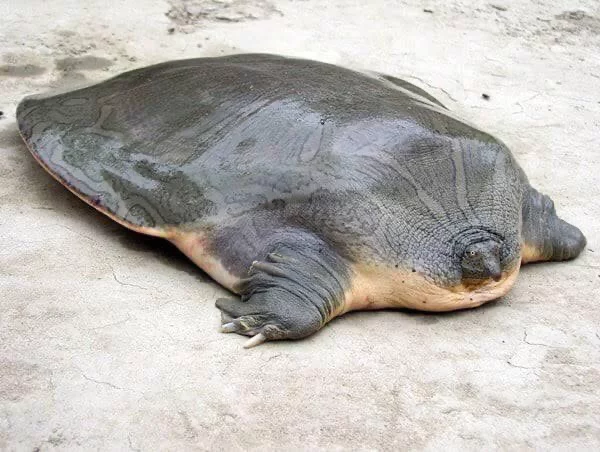Will a Turtle Without a Shell Survive?
Have you ever wondered, “What would a turtle look like without its shell and would it survive?”
I mean, as a turtle enthusiast and animal expert, it’s a question that’s crossed my mind too! But here’s the thing: that’s like imagining a human without their ribcage. Strange, right?
Anatomy of a Turtle’s Shell
Understanding the anatomy of a turtle’s shell provides insights into the essential role it plays in the life of these unique reptiles.
The Composition
A turtle’s shell is not a simple, rigid structure; it’s a complex combination of bones and keratin. At the base, you have around 50 different bones, which include the turtle’s spine and ribs.
These bones fuse together to form a robust skeletal structure. Covering these bones are large plates called scutes, which are made from keratin – the same material as our fingernails!
The Protection Mechanism
As mentioned earlier, a turtle’s shell functions as a shield. But how exactly? The hard outer scutes deter predators and provide a solid barrier against sharp teeth or claws.
The overall rigid structure of the shell, combined with its ability to tuck its soft parts inside, makes it a formidable fortress against potential threats.
The Role in Movement
Apart from protection, the shell plays a vital part in the turtle’s movement. The shell’s underside, called the plastron, is slightly concave in terrestrial turtles, allowing them to have better grip and mobility on land.
Meanwhile, aquatic turtles have a more streamlined shell, helping them navigate better in water. When they swim, their shell cuts through water, reducing resistance and allowing them to move swiftly.
Connection to Turtle’s Spine
This might be one of the most mind-blowing facts for many. The turtle’s spine is adhered to the inside of its shell. This means the shell is not an accessory they can take off, like a piece of clothing; it’s an integral part of their skeletal system.
If you’ve ever looked closely at the pattern on a turtle’s shell, you’ve basically seen a topographical map of its spine and ribcage!
Growth and Moulting
As turtles grow, they don’t leave their shells behind for bigger ones. Instead, their shells grow with them.
Over time, turtles shed or molt the outer layer of their scutes, making way for new ones to grow beneath. This moulting process is natural and is a sign of a healthy, growing turtle.
Understanding the intricate anatomy of a turtle’s shell only deepens our appreciation for these magnificent creatures. It’s not just a protective casing; it’s a dynamic, living part of them that reflects their health, age, and even their experiences.
Why a Turtle Can’t Live Without Its Shell
The shell of a turtle is not just an ornamental or protective covering; it’s intricately woven into their very existence. The importance of the shell stretches far beyond mere aesthetics. Here’s why a turtle cannot survive without its shell:
Vulnerability to Predators
As touched upon earlier, without their shells, turtles essentially become easy prey. Their shell acts as their first line of defense. Predators like raccoons, foxes, and birds see a turtle’s shell and often recognize the challenge of getting to the soft, edible parts. Without this protective casing, a turtle would be defenseless and a much easier meal.
Exposure to Environmental Hazards
Turtles encounter various environmental elements daily. From the hot sun to abrasive surfaces, their shell acts as a protective layer against these elements.
Without their shell, turtles would be at risk of sunburn from UV rays, potential physical injuries from rough terrains, or even frostbite in cold conditions. The shell also plays a role in helping them regulate their body temperature.
Risk of Health Issues
The shell provides a barrier against infections and parasites. A turtle without its shell would be at heightened risk of bacterial and fungal infections.
Imagine an open wound that’s continuously exposed; the shell-less turtle’s entire body would be like that wound. Moreover, the shell acts as a support structure. Without it, internal organs could be easily damaged due to lack of support, leading to internal injuries.
Spinal Significance
We’ve already established that a turtle’s spine is fused to its shell. So, a turtle without a shell would mean a turtle without the necessary support for its spinal cord.
This could result in paralysis or severe physical dysfunction. A turtle’s shell and spine grow together, making them interdependent. Removing the shell disrupts this natural anatomy, leading to catastrophic consequences.
Emotional and Behavioral Impact
Turtles have evolved with their shells for millions of years. It’s a part of their identity. When threatened, turtles retract their limbs and head inside their shell, feeling safe and protected.
Without a shell, not only would they be physically vulnerable, but the constant state of exposure could also lead to stress and anxiety, affecting their overall well-being and behavior.
Myths About Shell-less Turtles
The world of turtles is fascinating, but with that fascination often come myths, especially when discussing the concept of shell-less turtles. It’s essential to separate fact from fiction to ensure our understanding and care for these creatures are rooted in reality. Here are some of the most common myths:
The Myth of “Regrowing”
One of the most widespread myths is that turtles can regrow their shells, much like lizards can regrow tails. This myth is entirely false.
As we’ve discussed, a turtle’s shell is a part of its skeletal structure, fused with its spine and ribs. Once damaged, while minor injuries might heal, the shell will not “regrow” in the way that some animals regenerate lost body parts.
“Shelled vs. Shell-less” Lifespan
Another common misconception is the idea that a turtle without its shell could potentially live longer due to increased mobility or some other perceived benefit. The truth is the exact opposite.
Without their shells, turtles are at a significantly higher risk of predation, injury, and disease, all of which would drastically reduce their lifespan.
“Turtles Can Outgrow Their Shells”
Some believe that as turtles grow, they can outgrow their shells and then find new ones, much like hermit crabs.
This myth is again rooted in misunderstanding. A turtle’s shell grows with it. They never abandon it nor seek a new one; it’s an integral part of their body.
“Shell-less Turtles Exist Naturally”
With so many diverse species in the animal kingdom, some people think there might be a species of naturally shell-less turtles.
This is not true.
While there are soft-shelled turtles, they still possess a shell, albeit a more flexible and leathery one. There’s no species of turtle that exists without a shell altogether.
“A Damaged Shell is Purely Cosmetic”
If a turtle’s shell gets damaged or cracked, some believe it’s a mere cosmetic issue and doesn’t affect the turtle’s health.
This notion is dangerously false. A damaged shell can expose a turtle to infections and other health issues. It can be likened to a broken bone in humans and requires immediate attention.
“Turtles Can Feel Nothing Through Their Shells”
Some people think that a turtle’s shell is akin to the sole of a shoe, insensate and unfeeling.
This is inaccurate.
Regardless of the type of turtle, turtles can indeed feel pressure and touch through their shells, as they have nerve endings there. That’s why they often respond when their shells are touched or tapped.
In understanding and debunking these myths, we equip ourselves with knowledge that allows us to appreciate, care for, and respect turtles in a more informed way. Embracing the facts ensures we provide the best environment and care for these amazing creatures.
Caring for Turtles: Best Practices
As someone who loves these creatures, here are some suggestions:
Keeping Them Safe
Ensure your pet turtle has a safe environment, free from potential threats. Regularly check for any shell damage.
Monitoring Their Health
Regular vet check-ups are crucial. Remember, a healthy shell means a healthy turtle!
A Turtle’s Shell Conclusion: Cherishing Our Shelled Friends
A turtle without its shell is, well, not a turtle. It’s essential to their identity, health, and survival. Let’s ensure we treat these shelled wonders with all the care and respect they deserve!
A Turtle Without a Shell FAQs
Can turtles feel pain on their shells?
Absolutely! Their shell has nerve endings, so they can feel sensations.
Do turtles ever come out of their shells, like in cartoons?
No, they don’t. That’s a popular misconception. They’re attached to their shells!
Is it okay to paint or put stickers on a turtle’s shell?
It’s not advisable. It can harm the turtle and affect its health.
How can I ensure my turtle’s shell remains healthy?
Provide a balanced diet, clean living environment, and regular vet check-ups.
What if my turtle’s shell is cracked?
Consult a vet immediately. They will guide you on the necessary steps.
Other Pet Info:
Do Dogs Have Belly Buttons? Fact or Fiction?




